Lev's Book Tour in Austria & Germany (2007)
I recently spent two weeks in Austria and Germany on a publicity tour for Yiddishkeit oder Das eigene Leben, the German translation of Secret Anniversaries of the Heart. I read at American cultural centers, bookstores,
libraries, and the Jewish Museum in Vienna. In a lovely surprise, the bookstores served Prosecco or
Sekt (Venetian and German sparkling wines).
I was joined by a German reader at each venue who read part of the story in German. I read in English and answered questions in English but introduced the evening and the book in German, which was fun for me and a surprise for my audiences, since American and English authors don't usually do that.
Germany continues to fascinate me after my third trip and I left Berlin, Germany's most exciting city, with a contract from my German publisher for a book about my experiences in Germany and what the country has meant to me in the past and how I feel about being there now.
The weather was often surprisingly warm and sunny, sometimes topping 80 degrees, especially in Munich and Berlin, cities where I had two free days each for exploration. Best of all, in Berlin, my publisher Parthas Verlag assigned me a guide to take me anywhere I wanted to go and we had extensive conversations
about—what else?—Germany and the Germans.
Favorite German drink on a warm day: A radler, which is a light or pilsner-style beer mixed with 1/2 lemon-lime soda. Favorite activity in Germany: people watching from a sidewalk cafe, especially in Berlin's hip, multi-ethnic, very mixed Kreuzberg neighborhood. Favorite food in Germany: fresh white asparagus with boiled parsleyed potatoes. Favorite spot: the terrace of an Italian restaurant down the street from my hotel in Munich's quiet, luxurious Nymphenberg
neighborhood. Favorite museum: Munich's Glyptothek displaying Greek statuary and enjoying its 175th anniversary.
See photos from Lev's 2005 German tour!
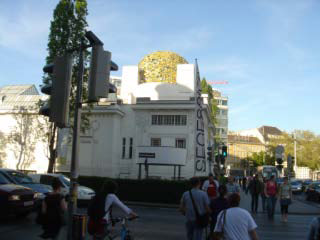
Vienna's remarkable Secession Museum, built in 1898, with its dome of gold laurel leaves, made a great landmark for me as it was just a few blocks from my hotel and quite visible from a distance. |
|
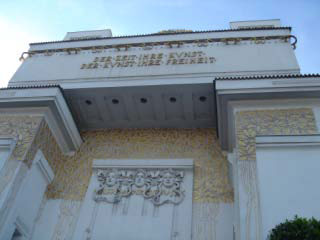
"To the age its art, to art its freedom." And the three gorgons above the door represent Malerei, Architektur and Plastik: painting, architecture and sculpture. |
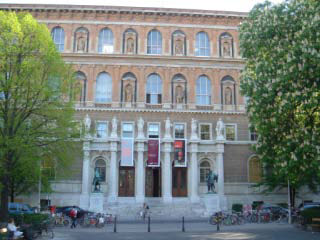
One of the very many stately and imposing Renaissance-inspired buildings in Vienna, where I read at the Jewish Museum. |
|
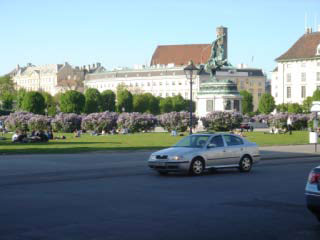
Lilacs in bloom at the Hofburg Palace, which Emperor Franz Joseph never had the money to finish. |

The Balcony from which Hitler addressed throngs of hysterical admirers after the Anschluss joined Austria to Germany. |
|
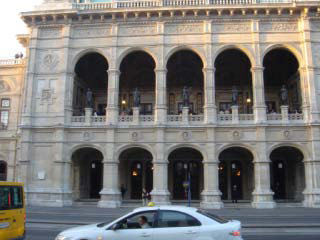
The Vienna State Opera's architecture was not well thought of even before the building was officially opened, but the criticism faded when its architects died. |
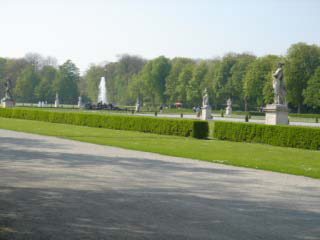
Part of the vast grounds of Nymphenberg Palace in Munich, just blocks away from my charming hotel. Imagine a slightly scruffy version of Versailles. Beautiful vistas were everywhere, but nature was less tamed than the French model. |
|
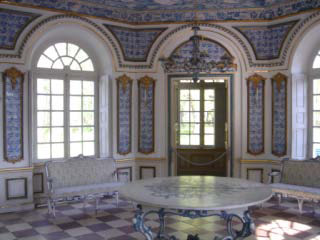
The exquisite tiled interior of one of the many pavilions dotting the grounds, which take three hours to walk if you're not a rushed American and then of course there's the Weissbier waiting for you at a cafe. Gersh called on my German "handy" just as I was served—great timing! |
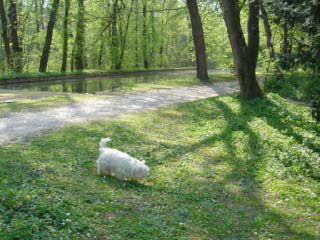
A Westie named Sheila I encountered on the grounds. It's a very popular breed in Germany, and they always reminded me of my guys at home, as well as aiding me initiate German conversation with strangers. |
|
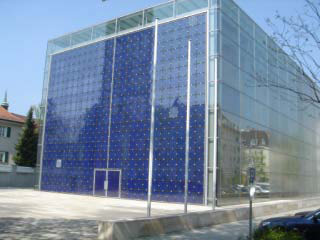
Herz Jesu Kirche a few tram stops from my hotel. A Munich friend said it's rarely visited by tourists and was both architecturally unusual (all that glass) and highly spiritual. I agreed on both accounts and was there alone. |

A view of my favorite restaurant in Munich, an Italian place with lovely little terrace where I sipped and sat and wrote in my journal or just daydreamed. Dolce far niente. |
|
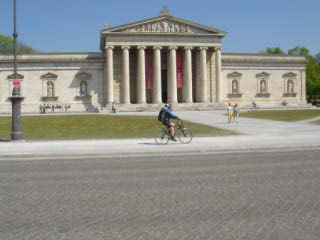
The world-famous Glyptothek at Koenigsplatz in Munich, celebrating its 175th year as a repository of amazing Greek and Roman statuary. The cool, high halls are a perfect backdrop for the sculptures. |
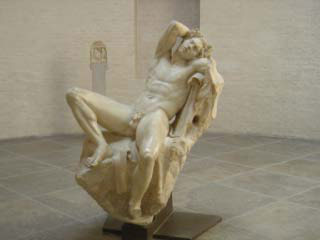
The celebrated Barberini Faun which Nathanial Hawthorne and Henry James have both written about. It's in a round room and the space encourages you to keep circling it, studying it. |
|
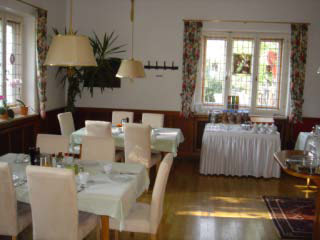
The cheerful breakfast room of my Munich hotel where I spent three peaceful, quiet nights, sleeping nine hours every night. The hosts were half-German, half-French and I had fun chatting with them in three languages. |
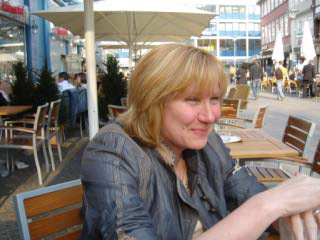
Ulrike Schuh-Fricke, my host in Braunschweig, where I spoke once again to teachers of English. We were having a latte macchiato in one of the many cafes in the downtown pedestrian mall. |
|
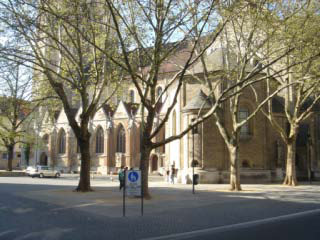
The thirteenth-century Dom (Cathedral) in Braunschweig, a cool, contemplative space inside and rather more imposing outside. The downtown is a chaotic mix of old and new. |
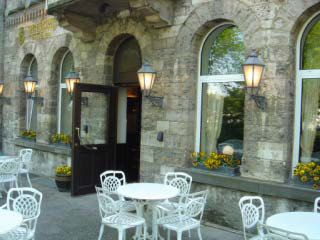
The terrace of my 4-star hotel in Goettingen, which is right next to the running track that marks the old city walls.
It made me feel even more relaxed when joggers huffed past. |
|
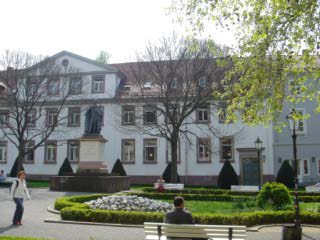
A charming 18th-century square in Goettingen, a university town attractive to people of all ages because of its cultural life. |
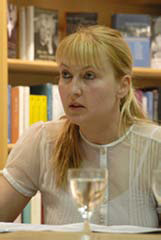 Birgit Nipkau reading part of "The Tanteh" in German. Birgit Nipkau reading part of "The Tanteh" in German. |
|

Reading the conclusion of "The Tanteh" at Dauerlich Bookstore in Goettingen. |
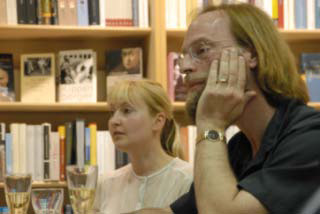
Q&A at Dauerlich Bookstore. |
|
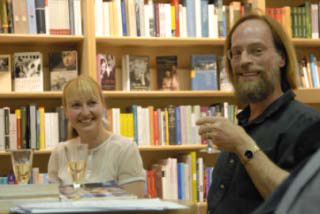
Relaxing after the reading with some Sekt (which we did not drink during the reading, I promise). |
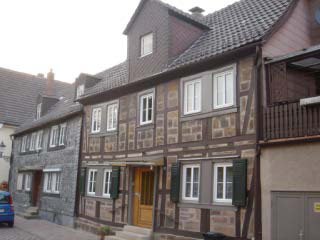
A house built in 1683, down the street from my hotel in tiny Bad Arolsen, home of the IRC Tracing Center where I discovered the actual documents of my mother's persecution in Buchenwald. A very emotional afternoon. |
|
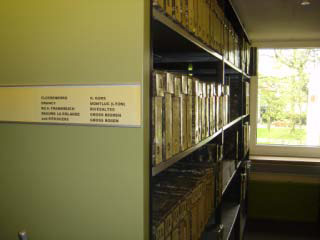
A small section of the records hall where millions of documents are stored and being preserved and digitized. |
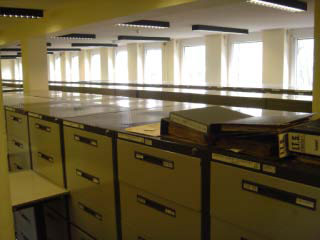
The Allies chose Bad Arolsen in northern Hesse because it had been untouched by the war and so its infrastructure was intact in 1945. |
|
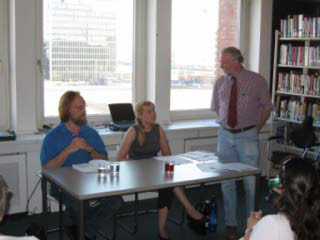
Being introduced at the American Center library by Manfred Strack, head of English language cultural programs in five northern German states. At my left is journalist Birgit Nipkau who read the German part in Goettingen as well. She had acting experience, so we made a good team. |

Answering questions after my reading. The building is in the old warehouse area of Hamburg that is booming, and I learned that the beans for one of every six cups of coffee worldwide ship through Hamburg. |
|
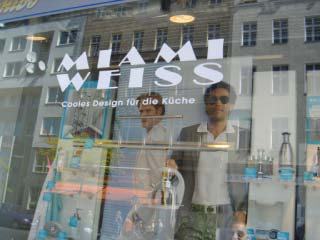
English crops up everywhere in German advertising, but this kitchen shop was more than usually clever: Weiss (pronounced "vice") means white and the kitchen gear inside was predominantly that color. |

A view of the "garden" from inside the new Jewish Museum by Daniel Liebeskind. The leaning towers, grounded in hard to walk on cobblestones, sprout olive trees: hope rising from a painful past. |
|
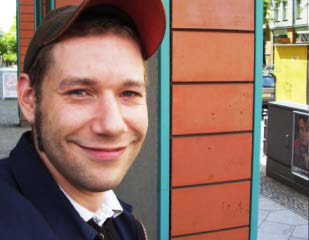
Clemens Kaiser, my erudite and witty guide to Berlin and all things German. |
All text copyright © 2001-09 by Lev Raphael.
|


















 Birgit Nipkau reading part of "The Tanteh" in German.
Birgit Nipkau reading part of "The Tanteh" in German.









